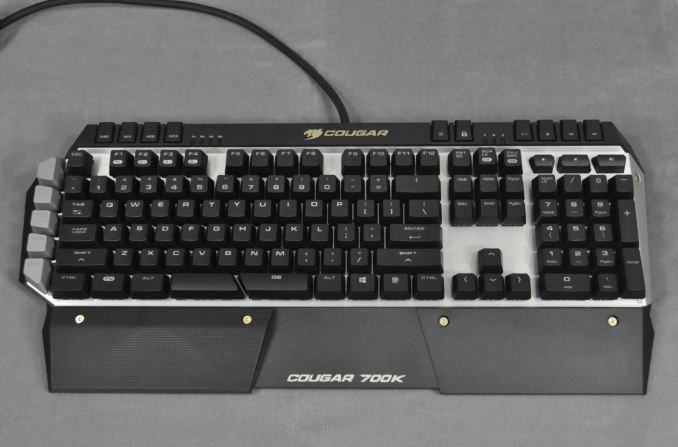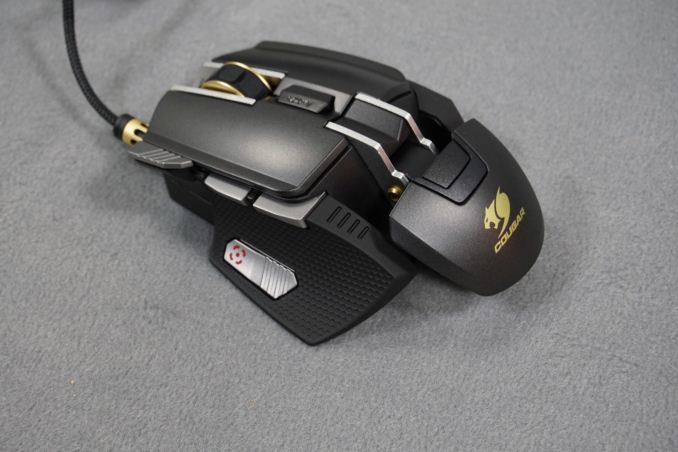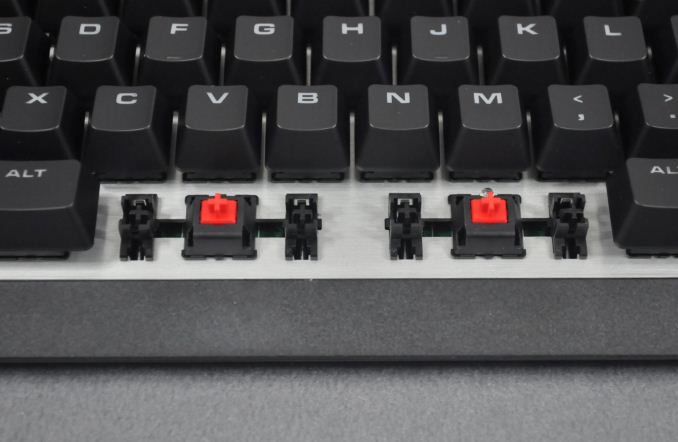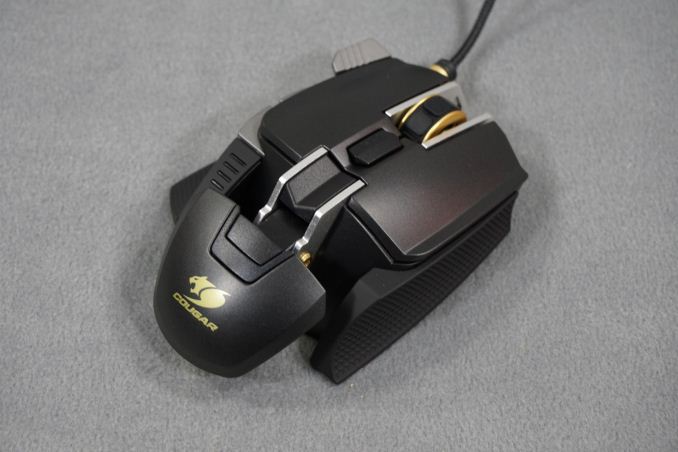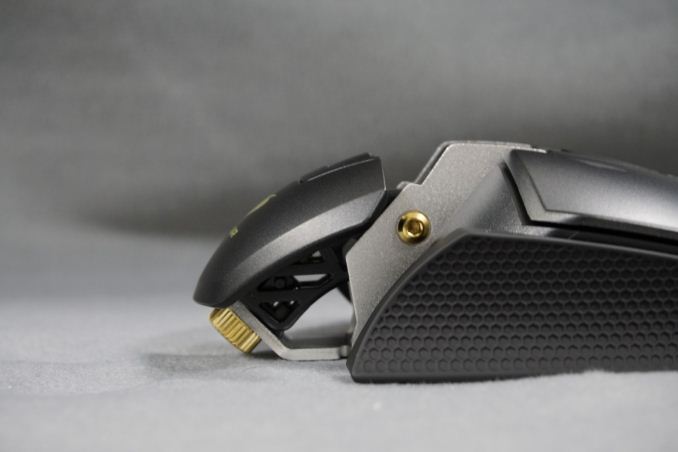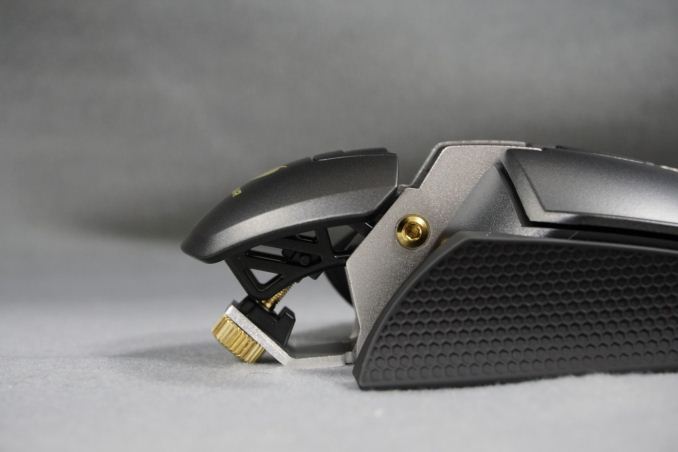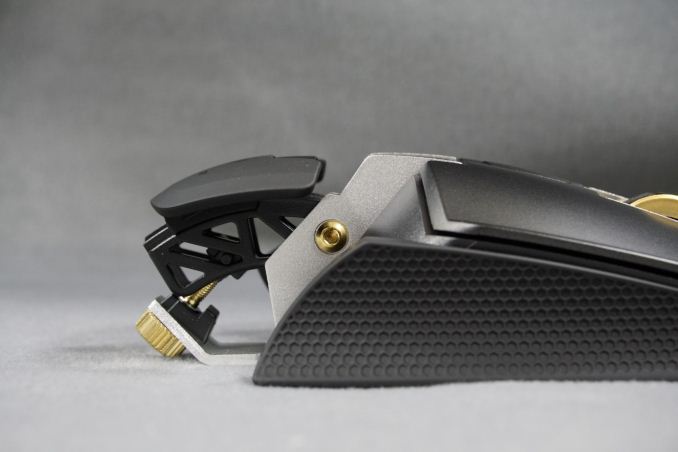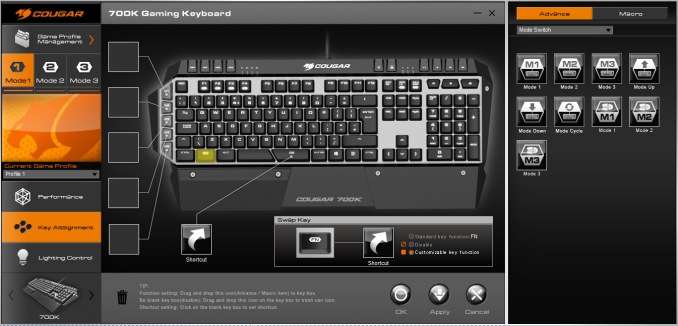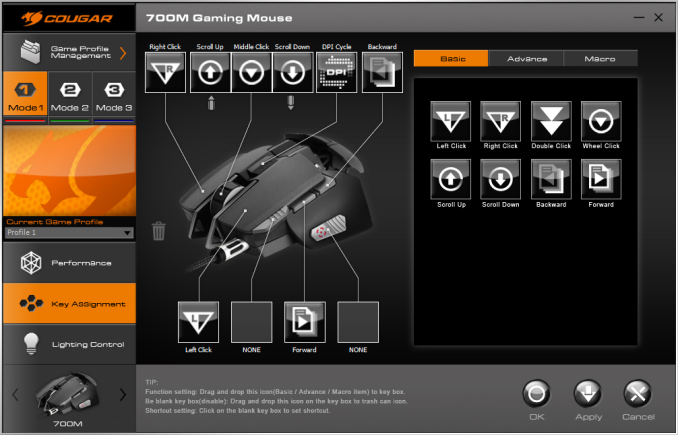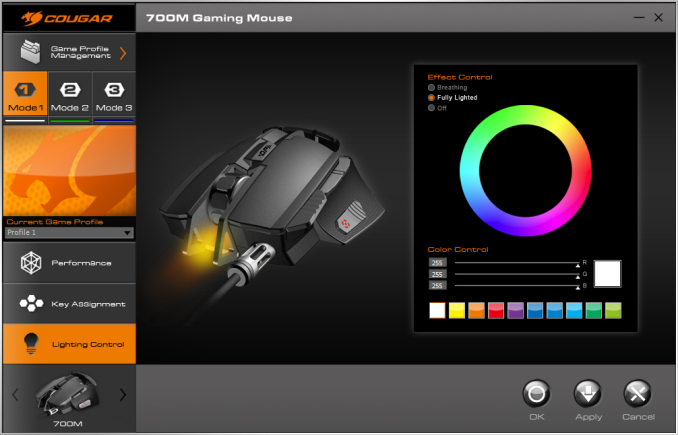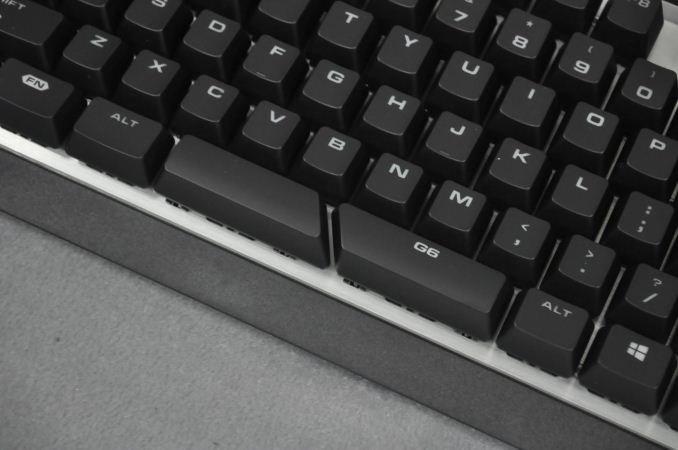
Original Link: https://www.anandtech.com/show/9000/cougar-700k-mechanical-keyboard-700m-gaming-mouse-review
Cougar 700K Mechanical Keyboard & 700M Gaming Mouse Review
by E. Fylladitakis on February 23, 2015 3:40 PM EST- Posted in
- Peripherals
- Keyboard
- Cougar
- Mice
- Mechanical Keyboards
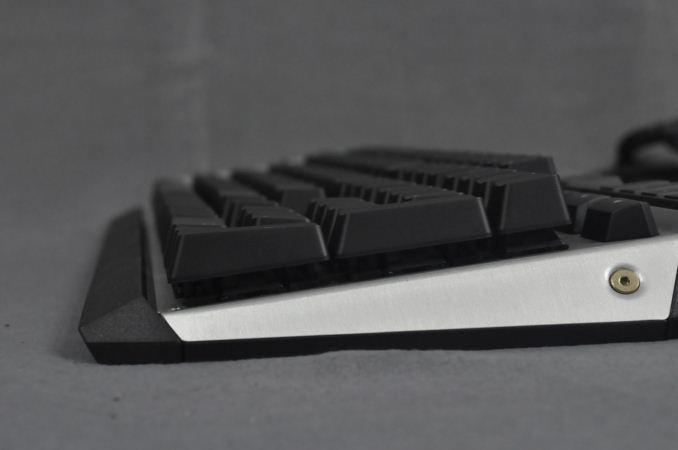
Introduction
Founded in 2007, Cougar is a relatively new manufacturer that has been making efforts to enhance their global presence. When we posted our first review of their extravagant Challenger case back in 2012, Cougar was just taking their first steps into the North American market. Nowadays, their products can be found in most parts of the world. The German company originally started as a case and power supply manufacturer over seven years ago, but more recently they have branched out into the advanced gaming peripherals market. Today we are looking at two of these new peripherals, the 700K mechanical keyboard and the 700M gaming mouse.
The 700K and the 700M are Cougar's best keyboard and mouse at this point of time. The 700K can be shortly described as an aluminum body, fully programmable mechanical keyboard with Cherry MX switches, while the 700M is an advanced ergonomic gaming mouse designed specifically for FPS gaming. Their specifications are, at the very least, impressive; unfortunately, so is their retail price, and not in a good way. The 700K and the 700M are retailing for $150 and $70 at the time of this review, pitting them against a long list of other similarly impressive products available from a dozen other manufacturers. Do they have what it takes to stand out from the crowd? We will find out in this review.
Cougar 700K Mechanical Keyboard
Key Features and Specifications
- Six programmable G-Keys
- FPS Palm Rest
- Individual Key Backlighting
- 32-Bit Arm Processor
- Cougar UIX System
- USB & Audio Jacks
- 1000 Hz Polling Rate
- Full key backlight
- On-the-fly macro recording key
- On-the-fly mode switch key
- Multi-media keys
- Windows lock key
- Detachable palm rest
- Non-slip rubber foot
- Braided cable and gold-plated connectors
Cougar 700M Gaming Mouse
Key Features and Specifications
- Aluminum framing structure
- Muzzle brake SR
- Multi-Color Backlight
- Fire/Sniper Buttons
- 32-Bit ARM processor/512KB Onboard memory
- Weight Adjustment
- Tool-less Palm Rest Adjustment
- Interchangeable Palm Rest
- 8200 DPI Laser Sensor
- Eight programmable buttons
- Aero-dynamical system
- Cougar UIX system
- Cougar fusion
- 1000hz polling rate / 1ms response time
- On-the-fly dpi adjustment
- 4-stage dpi led display
- Omron micro switches
- Gaming-grade scroll wheel
- Gaming-grade mouse feet
- Braided cable and gold-plated USB plug
The Cougar 700K Mechanical Keyboard
Aesthetics are a subjective matter but we believe that most users will find the appearance of the Cougar 700K to be impressive. The design is futuristic, with enlarged lettering and the keys are secured directly on the aluminum surface, without a surrounding frame. From a purely practical point of view, the design makes such keyboards very easy to clean, as a simple blow can remove most debris from the aluminum surface of the keyboard. It is not entirely made out of aluminum though; the top half of the body is a brushed aluminum board but the rest of the keyboard is plastic. The detachable plastic wrist rest hosts one of the unique features of this keyboard – a secondary wrist rest can be magnetically attached to its left side, raising its height by a few more millimeters, making WASD or TAB-1234 gaming more comfortable. The secondary wrist rest also has a textured, non-slip surface.
The keyboard weighs 1.2kg and, ironically, Cougar is trying to market it as "lightweight". It actually is a rather heavy keyboard and that is a good thing, as it stays firmly in place even when the user is making intense movements and/or pressing a palm against the wrist rest. It is not clear why the company would try to market a 1.2kg keyboard as lightweight, as this is not a product designed for convenient transportation anyway; gamers that move around a lot would be looking for a far more compact and, most likely, tenkeyless keyboard.
Aside from the typical 104 keys of a full size keyboard, the 700K has a number of extra keys as well. To begin with, there are six programmable keys can perform any macro or action. Five of them are the grey keys to the left side of the keyboard, while the sixth is the right half of the spacebar. The split spacebar key is perhaps the most interesting part of the 700K, in a variety of ways – it allows the user to have two programmable keys accessible by thumb and distributes the actuation force more evenly while typing.
The mechanical switches beneath the 105 keys (104 basic keys + 1 of the split spacebar) are supplied by Cherry. Our sample came with MX Red switches but the 700K is also available with MX Brown. Cross-type supports can be found under the larger keys, preventing wobbling and distributing the actuation force more evenly, meaning that the key will require about the same actuation force regardless of the pressure point. As for the lighting, LEDs have been installed beneath every key of the keyboard. Individual key backlighting is possible but the 700K is limited to amber/orange color backlighting only; it is not possible to adjust the color, only the intensity of the LEDs.
Four flat keys at the top left of the keyboard allow the user to initiate on-the-fly macro recording or switch between three programmable modes. Next to those keys, four LEDs indicate the current repeat rate. Six of these flat keys can also be found at the top right side of the keyboard as well. One controls the intensity of the backlighting, one locks the Windows key, and four provide basic media controls. Between these four keys and the numeric keypad, three tall plastic keys provide sound volume control. These are not as convenient as a volume wheel but they get the job done – they are however notably shorter than the rest of the keys so, depending on the position of the keyboard, the user might inadvertently press the Numpad's top row keys instead of them.
Finally, more options are accessible via the FN key, which replaces the Windows key at the bottom left side of the keyboard. The repeat rate of the keyboard can be adjusted by holding down the FN key and then pressing the F1 to F4 keys, while the FN + SCR LK and FN + Pause combinations control the key rollover mode. However, as these options are found in the keyboard's software as well, the FN key is not of practical importance and most users are likely to reprogram it to function as a Windows key again.
At the back of the keyboard, there's a single USB port and 3.5mm audio jacks near its right side. Having a USB port there can be very convenient for wired mice or for users whose the computer is not easily accessible, such as under an office desk or otherwise hidden. There is nothing of note on the bottom of the keyboard, only anti-skid pads and two basic height adjustment feet.
Inside the keyboard, we found an excellent assembly and an immaculate soldering job. The keyboard consists of four PCBs – the main PCB that holds all of the main keys and components, two PCBs for the keys alongside the top of the keyboard, and one PCB for the USB port and 3.5mm jacks. An NXP LPC11U14F-201 is the core processor of the keyboard, accompanied by a Holtek HT1632C LED driver. This NXP microcontroller is one of the fastest available for mechanical keyboards today but, unlike the NXP LPC11U37F-501 that other premium offerings are using, it "only" has 32kB of flash RAM. Considering that the 700K lacks RGB lighting or too many macro keys, the LPC11U14F-201 should be more than sufficient.
The Cougar 700M Gaming Mouse
It's readily apparent that the 700M gaming mouse has been released to go alongside the 700K keyboard, so much that we wonder why Cougar does not offer them as a bundle as well. Both are specifically targeted to FPS/RTS gamers and the UIX software can interconnect their functions. Of course, the company claims that this mouse is also suitable for MMORPG gaming but it would not be our first choice for that. Cougar surprisingly invested a lot into the creation of this mouse – two years of R&D, the company claims. Their effort seems to be paying off, as the 700M received two awards already – the Computex Design and Innovation and the iF Design awards.
The 700M gaming mouse is unique in a number of ways, the most notable of which is the use of an aluminum frame. Most gaming mice are entirely plastic or have an aluminum bottom plate, while the 700M has a frame that extends to the top of the mouse. The rest of the mouse is still plastic of course but, according to Cougar, the aluminum frame makes the 700M "more rigid and robust". It's also relatively lightweight, as the 700M weighs just 110gr, but it is a colossal exaggeration to suggest that the aluminum frame is going to increase the mechanical cohesion of a mouse, at least to a degree noticeable by the user. It is cool to have but many high performance gaming mice are made entirely out of plastic and their structural integrity remains excellent.
Cougar went with an "open" design that provides support where necessary and allows the user's palm to breathe. The top plastic parts are satin and smooth, as with the vast majority of mice, for increased comfort. The side plastic parts are much thicker, made out of corona treated plastic that feels softer and more comfortable while increasing the user's grip. To increase the grip even further, Cougar etched a honeycomb pattern on the side covers as well.
Including the two basic and the wheel's button, the 700M has eight programmable buttons total. There are two "forward/backward" side buttons, one "DPI selection" button beneath the wheel, one "fire" button next to the left main button, and one "sniper" button on the left side grip. The fire and sniper buttons are unique features of the 700M and their positioning can be very convenient for FPS gaming. Cougar placed the sniper button on a 45° angle, claiming that it improves the hand's stability while aiming. It does feel comfortable and is easy to use, but horizontal side buttons should not be creating stability problems either. The function of these buttons can be programmed via the UIX software.
Another unique feature that Cougar is proud of is the "Muzzle Brake SR" metallic tube that can be seen at the front of the mouse. Aside from the fancy name and "gun barrel appearance", it is simply a metallic tube that provides mechanical support to the cable. It is a feature that most users will find redundant, except for those that are overly violent while gaming and tend to tear the cables out of the mice they use.
Next to the cable insert and beneath the scroll wheel, Cougar installed RGB LED lighting. Three LEDs (Red, Green and Blue) have been installed so as to project one color on the mousepad/desk. The lighting can be continuous or have a breathing effect, and different colors can be linked to each mode, allowing visual confirmation of mode changes by the user. The only small issue here is that the aluminum frame reflects and changes the wavelength of the LEDs, which means that combined colors may cause multiple colors to appear under the scroll wheel. For example, for white (all three LEDs at maximum intensity), all three color hues appear beneath the scroll wheel, even though the color being projected on the mousepad is white.
At the front of the mouse, beneath the palm rest, there is a golden thumbscrew. This can be used to adjust the height of the palm rest, up to making it almost parallel with the surface. The palm rest can also be changed with a smaller, "sport" version that Cougar supplies alongside the mouse. The smaller version should feel more comfortable for users that prefer a "claw grip" and move the mouse around with their fingers.
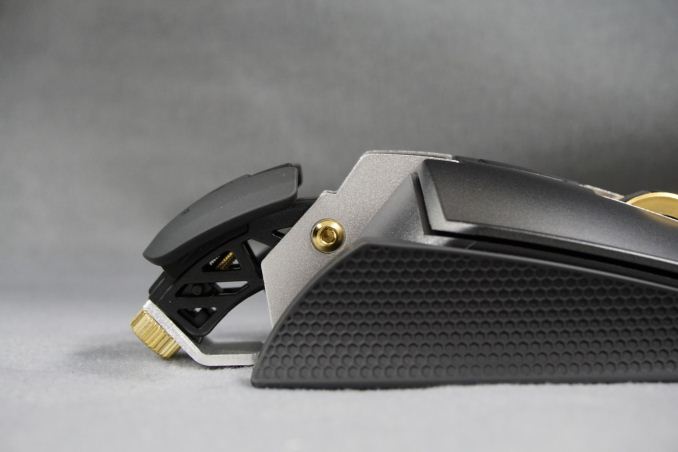
Highest and lowest palm rest setting, stock palm rest (up) and sport palm rest (bottom)
The weights of the 700M are hidden just beneath the DPI button. Four 4.5gr button weights are provided, allowing the user to adjust the weight of the mouse from 110gr up to 128gr. Still, even with the weights installed, the aluminum frame of the 700M makes it a very lightweight mouse. Hardcore gamers who are used to playing with heavyweight mice might be disappointed at first, but the low weight of the 700M is not difficult to get used to. Strangely, Cougar does not provide any container for the weights that the user chooses not to install.
Cougar UIX System Software
The UIX System is the software that accompanies all of Cougar's advanced gaming peripherals. It allows the control of multiple devices from the same interface, as well as the transfer of commands from one device to another – and that is the primary reason why we reviewed these two products together in a single article.
In terms of simplicity, the UIX System interface is fairly user friendly and straightforward. Once you install the software modules for the devices that you own, the software recognizes them automatically and will immediately check for software/firmware updates. The user should be careful at that point, as the software does not ask for confirmation once a new firmware has been found – it will immediately proceed with the updating process and forcefully stopping it can permanently damage the device.
For any Cougar device that is connected, the UIX System has three main sections – performance, key assignment, and lighting control. There is also a Game Profile Management section, which allows the user to save multiple profiles. Each profile has up to three modes, allowing on-the-fly setting changes via the keyboard's mode switch keys or other programmed keys. Each mode may have entirely different performance, key, and lighting settings.
For the 700K keyboard, the performance section allows the user to control the polling rate, the key rollover, the repeat delay and acceleration, the backlighting mode, and the sleep mode. The polling rate and key rollover settings are pretty much self-explanatory; you'll want these at the best possible settings (1000 Hz, N-Key Rollover), unless there are compatibility issues with your system. Cougar's repeat delay and acceleration options allow the user to control how quickly an actuated key will start repeating itself and how that repeating will accelerate over time. There is a small test box for the user to check the settings.
The backlighting mode settings allow the user to select from normal "always on" lighting, "click" lighting (the LEDs momentarily light up when the key has been actuated), and three lighting effect modes. One of these three lighting effect modes can be programmed to start automatically once the keyboard enters its "sleep mode", which can be programmed to initiate when no key has been pressed for two to eight minutes (or it can be turned off entirely).
The UIX System also presents the Mode Sync option in this section. If this option is enabled, switching modes using the keyboard's mode selection buttons (or other programmed buttons) will switch the mode of every other Cougar device as well. For example, if Mode 3 is selected from the 700K keyboard, Mode 3 will be activated for the 700M mouse as well. This option can be disabled, allowing the user to switch modes on the keyboard independently from other Cougar devices.
As for the 700M mouse, the performance section is focused on DPI and speed settings. There is an option to adjust the polling rate but, once again, the user should leave that at maximum unless there are compatibility issues. Up to four DPI settings can be programmed in each mode of the 700M, as well as a "Sniper" mode that is active while the corresponding hotkey/button is pressed. The software allows for the separate programming of the X and Y axes, which can lead to very advanced (and complicated) sensitivity options. It is also possible to adjust the lift height, as well as the double click, scroll, and pointer speeds. The scrolling can also be set to "one screen at the time".
A small box enables the hardware acceleration of the mouse – this does not affect the software acceleration of the OS, which needs to be disabled manually. If you want no acceleration at all, the Avago ADNS 9800 Laser sensor can disable the inherent hardware acceleration, or at least reduce it to a level imperceptible by the user, but remember to disable all software acceleration as well.
As there is no ability to change the backlight color, the lighting control of the keyboard is very simple. All the user can do is activate or deactivate the lighting of individual keys. There is a quick option that turns the backlighting of every key on or off as well. It is also possible to adjust the backlight key settings with up to five options, which may include backlight intensity and effect settings. It is not possible to create new effects, however; only preprogrammed effects may be selected. Remember that the lighting settings are tied to the mode – switching modes will switch the lighting settings as well.
The lighting control section of the 700M is very simple as well, but the user has access to RGB lighting. It is possible to adjust the projection color to virtually millions of combinations, but in practice one won't be able to discern the difference between more than a handful of colors. Cougar provides a color wheel and ten preset color settings for convenience. The lighting can also be set at maximum intensity, which is not very strong to begin with, or to a breathing effect.
The key assignment section is very similar for both devices and, as the name suggests, it's the section where the user can change the settings of every key on the keyboard or mouse. When the setting of any key has been changed from its default action, it will turn yellow on the pictured key map. For the keyboard's six macro keys, larger boxes display the programmed functions. The user can select from standard single keystroke actions, advanced options, or programmed macros.
The advanced options include mode switch keys, media functions, and program launch commands. It is interesting that the mouse-related functions can be programmed on the keyboard as well, as for example DPI switch settings and the "Sniper" mode that decreases the DPI setting of the mouse while the key is actuated. This can result in interesting gaming setups, allowing better control of mouse options from the keyboard. For example, for FPS gaming, the Sniper mode can be programmed on the right half of the Spacebar key, allowing faster and more convenient use of this option.
The built-in Macro recorder is relatively simple but very functional. It allows the programming of macros that may or may not include mouse movements (in either absolute or relative coordinates too). It also supports natural, preset, or no delay times between actions. Once the macro has been recorded, delay times and mouse coordinates can be manually edited by double-clicking on them. The macros can be set to play once, repeat a number of times, or repeat continuously until the button has been pressed again.
The macro recorder lacks only two things – the option to return the mouse pointer at its original position after the execution of the macro has been completed and the ability to start/stop recording via a hotkey. Both omissions are equally important but the second will prove to be more annoying, as the software will record both the ALT+TAB keystrokes and the mouse movements from switching back and forth to another application/game, which means manual editing/cleanup of most recorded macros is necessary.
Conclusion
As with all peripherals that we review, the 700K and 700M were in use for several days for testing. The quality and sturdiness of the 700K Mechanical keyboard was immediately apparent – the aluminum plate increases the feel of solidity and the plastic parts are of excellent quality. The keys are very sturdy and the cross supports reduce wobble down to a minimum. Cherry, the most renowned manufacturer of switches, supplies their MX series products for the main keys. Our sample came with the soft and linear MX Red switch but the 700K is also available with MX Brown switches that provide quiet tactile feedback. Cougar installed very good switches beneath the media/mode keys as well, similar to those used for the main buttons of a mouse, which have a very short actuation distance and a strong click feedback. These buttons are very firm and their feel is excellent.
The design of the 700K mechanical keyboard is very good, both aesthetically and functionally. Cougar's idea to split the Spacebar key is innovative and can be very practical, and it improves the force distribution. The Spacebar key is the most problematic key of any mechanical keyboard, as its length and weight creates a much different feel than the rest of the keys. By splitting it in two and using two switches, which also are much closer to where the thumb hits the key, Cougar vastly improved the feeling of the keyboard without having to use a different switch under the Spacebar. MMORPG users might complain that the number of macro keys is relatively low, but every key of the 700K is programmable; as such, the user can create gaming modes where, for example, the numpad or function keys are repurposed to perform macros.
Although the 700K mechanical keyboard is exceptional, the 700M gaming mouse does not fall behind either. In terms of design, working with the mouse for just a few hours makes it easy to see how it earned two awards in a single year. It is not only about the looks, but it's also about the user comfort and functionality as well. The 700M is very comfortable to grip and use, while its low weight increases long-term usage comfort – if you are right-handed, that is. The ability to change the palm rest and adjust its height increases the user's comfort even further, allowing a perfect fit for virtually anyone's hand. FPS gamers will especially love the presence of the Sniper and Fire buttons. It is not very suitable for complex MMO gaming though, as the number of keys is low and advanced gamers will almost certainly want more, regardless of the number of macros that can be programmed on the keyboard.
The quality of the 700M is excellent as well, although not because of its aluminum frame. The aluminum frame may improve the robustness of the mouse, but any change is both imperceptible and unimportant to the end user – besides, all of the components that are attached on the frame are plastic. However, the quality of these plastic parts is very good, as well as that of the switches. The metallic "muzzle" that supports the braided cable minimizes the chance of ripping it off after long and violent gaming sessions. Of course, if you are this violent when gaming, a good book on self-control would probably help more than a mouse that is built like a tank.
As for the UIX System software, it is relatively simple and very user-friendly, providing a wealth of options and customizability without scaring away the less advanced user. It is not without problems – in fact, the early versions that were supplied to us when we first received the samples were littered with bugs and had serious stability issues. Cougar's programming team however seems to be working very efficiently, as the vast majority of those bugs are gone in the most recent version of the software that we tested (v1.14 and v1.17 for the 700M and the 700K respectively). It could be further improved and more options can be introduced, yet the UIX System already is one of the better software packages that accompany advanced gaming peripherals today.
Both the 700K mechanical keyboard and the 700M gaming mouse are exceptional products, of very high quality and offer great functionality. Their only true enemy is their high retail price, which places either of them against numerous other similarly excellent products. At the time of this review, the 700K retails for $150 including shipping, a price that is fair for a keyboard of this level but there are numerous other options near this price range. For example, $20 more can bring you the Corsair K70 RGB, a keyboard with no macro keys but fully programmable and with RGB lighting, or the Razer Chroma, a keyboard with RGB lighting and macro keys but Razer (Kailh) switches instead.
The 700M gaming mouse retails for $70 including shipping, dangerously close to the similar Corsair M65, the popular Mad Catz R.A.T.5 and the wireless Logitech G602. Cougar's offerings are neither worse or overpriced, but they're not an astonishing deal that would drive us to recommend them blindly. However, if you are looking for advanced gaming peripherals within that price range, they are definitely worthy of consideration.

